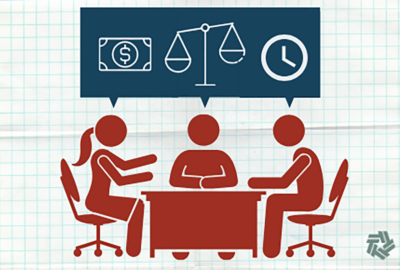What the just-out Federal Employee Viewpoint Survey results tell us
The Federal Employee Viewpoint Survey scores came out just before Christmas. And the results, in general, seem to be pointed in the right direction.
The Federal Employee Viewpoint Survey scores came out just before Christmas. And the results, in general, seem to be pointed in the right direction. For early analysis, the Federal Drive with Tom Temin spoke with a partner and the Director of Government and Public Affairs at Shaw, Bransford and Roth, Jason Briefel.
Interview Transcript:
Tom Temin Of course, you have followed this stuff very carefully for years now. And what’s the big picture? What are the five scores look like for 2023?
Jason Briefel So the big picture is a good one. The scores are trending upward a little bit, but in a noticeable way, after a two year kind of dip coming out of the heavy 2020, year of the pandemic. So in the framing of OPM, who issued this report, and in my read of it, in the big picture, that’s a good sign we’re going up.
Tom Temin So the sense of engagement and the sense that on employees part that leaders actually lead and so on, those scores are up a tick.
Jason Briefel Yes. And I think that it’s important to parse those out. Engagement is up a point overall to 72. And in the leaders lead, there are some indices that break that down. Is that the political leaders or the leaders on high, is that your direct supervisor? And one of the great things about this report is it shows us over time and I was happy to see, and I think it’s notable that the supervisor score has been about 80% consistently across time. And as we know, your front line supervisor, that’s where the rubber meets the road with the workforce.
Tom Temin Right. That will make you leave or stay much more readily than almost anything else going on.
Jason Briefel Absolutely. And I juxtapose that to the leaders lead category where those can be perceived and they are historically, this is a question in the survey where it’s unclear, they talking about the secretary in the front office or SES nearby the front office, but still maybe the career folks. Those scores are about 20 points lower. They went up two points to 61. But there’s a big difference there. And I think that’s important area for agencies to keep investing in paying attention to.
Tom Temin The political leadership and how it is perceived.
Jason Briefel Unclear if it’s political or career, but it’s those higher level leaders. What’s the tone that they’re setting in the organization? What leadership values are they articulating and guiding the workforce hopefully with?
Tom Temin It’s really hard to attribute a given factor to the scores. I mean, you can say, well, they’re getting a 5.2% pay raise, but that wasn’t extant at the time the survey was taken.
Jason Briefel Right. And it’s important to realize when this survey was taken in the spring of this year, this is when agencies were getting inklings that they were going to be pushed to come back into the office a little bit more. On the eve of an OMB memo focused on organizational health and performance. But it was a government wide census. So they sent it to everybody and 39% of the workforce responded. So decent, not great, but a decent population. And that was something that I found interesting, Tom, looking at the data here. The people who responded to the survey tended to be higher graded and older than your average federal workforce. So as I look at the data, I think it’s important to realize that we’re under sample two are underrepresented the Gen-Y and the Gen-Z population, and that’s where our gap is in the workforce.
Tom Temin And they have different attitudes toward work, different attitudes toward supervision. You might even say, yeah, which leads to the question about whether people perceive that their agency leadership will do anything with the scores they get agency by agency.
Jason Briefel So across the board that one is not really good. That’s one of the very lowest scores in the survey in the government wide data, this is question 47. Only 48% of respondents thinks that the survey will be used to make their agency a better place to work. So again, you have this disconnect. If you’re going to survey your workforce about this stuff, you have got to put it into action and show them fast that you’re doing something about this. And I’ve been talking and doing stuff around this for 11 years now, and that theme has been the constant theme. And hopefully agencies are getting better at that and they really have no excuse if they’re not because OPM is getting much better at putting this data in their hands faster.
Tom Temin Sure, it’s like grandma asking if you’re hungry and you say yes, but she doesn’t have anything to feed you. So it was just a matter of curiosity that doesn’t sit to well with people.
Jason Briefel Right. And again, I think the data is there. I think that as we go forward into the future, it’s wonderful to have the dashboard that OPM presents where you can dig in and into the data and and look what’s going on there, what’s going on at my agency, what’s going on at similar agencies. And hopefully we get to a place in the future in the federal government where this isn’t a once a year Christmas present from OPM. It’s more of a normal course of business. We’re using this data to manage our workforce all the time.
Tom Temin We’re speaking with Jason Briefel. He’s a partner and director of government and public affairs at the law firm Shaw, Bransford and Roth. And people love to see which agencies are doing great, which ones are doing terrible. And there was a bad slippage in one very large agency wasn’t there?
Jason Briefel There was. The Social Security Administration continues its fallout. This is a combination of, I think, a lot of factors, their workload, the nature of their work, how far they’re able to get in modernization initiatives there. And then they’ve had an acting leader for most of the Obama administration, most of this administration, obviously.
Tom Temin And they didn’t like the leader they had during the Trump administration, rightly or wrongly.
Jason Briefel Did not like the commissioner that was in from the Trump administration and somewhat controversially fired that official. But, I guess good news coming. The Senate finally confirmed Martin O’Malley (D-DC) to lead that agency, and I know he knows that he has a full plate to tackle, but has the experience as an as an operator, an administrator that hopefully can help focus on the critical needs of that agency.
Tom Temin Former Maryland governor. And at the tiny agencies, I think the Chemical Safety Board shot up 23%. There’s only a few people at that agency, but we see this year after year, sometimes some tiny obscure agency. The Marine Mammal Commission did really well a couple of years ago simply because of sometimes new leadership.
Jason Briefel So I don’t know what happened there, but I definitely saw that Chemical Safety and Hazard Investigation board something along those lines, I’m sorry, to folks who work there, if I butchered your agency title. And I think you’re right, Tom. Stuff can happen fast. You can drop out the bottom, you can rise to the top. And I think that that is a positive lesson for agencies listening out there. The scores are not your destiny. The scores are giving you information about what’s happening so you can go to where you want to go. And hopefully they’re used as a tool for improvement. And again, as I read into these, I think this really is be the start of the conversation, not the end of the conversation.
Tom Temin Now, the survey itself was a little bit different. They’re always tweaking it and there are some new questions and it’s hard to be comparable sometimes from one year to the other. What did you find this year?
Jason Briefel So I think that it’s good that you have this core set of questions, but that OPM’s also looking all the time. What are trends, what are key areas that we need to hone in on? And they may do that for various reasons. So obviously there’s a lot of focus around telework, remote work, things like that. So OPM tightened up the phrasing apparently that they used in some of their questions.. Are we talking about telework here? Are we talking about a remote worker? And so that helps get us more granular data about what’s happening with those people. And something that I think is really interesting and often gets lost in the debate about federal telework. But it’s clear as day in the survey in 2022, 20% of people in this year, 21% of folks said that they don’t telework at all. These are law enforcement people, people at the border, people in security, other types of security roles, maybe on a military base. So it’s really important to remember that there’s different populations of employees who have different experiences. I look at that against [Department of Health and Human Services (HHS)], had a great participation rate. Well, other than the folks in a lab, I’m going to guess that most HHS employees are at their desk all the time or a desk somewhere. And I think that that’s very different than, say, a Border Patrol or a Bureau of Prisons officer who might not even have a computer. They might just have an agency email account that they have to get to periodically. But that’s not really part of the core of their job.
Tom Temin A lot of variables depending on the job. And I would say, too, if scores are up in general and the level of telework that was engendered by the pandemic has not changed that much, even though there’s all this push, as you say, to get people back. But I think most agencies have settled at the most three days a week back in the office and scores are going up. That means that some level of widespread and regularized telework might be good for the workforce. I’m making a correlation here, but this is settled in now.
Jason Briefel Yeah, I think it’s settled in. I think if you look nationally at what’s going on in this space, about a 50% is the benchmark that in professional organizations we’re heading to. When you think about it, real estate is expensive. If you’re not using it all, you can shed it and then you can invest in training and development of your workforce, which is another one of those areas that the survey added some new questions around and 2022 and we’re starting to see data. And it was interesting that was another one of those where it ranked on the lower side of agencies getting the training investment that they need to successfully do their job right.
Tom Temin So signal to agencies, we know you always cut back on training and development, but it’s never a good idea.
Jason Briefel No, I don’t think so. And I think in an area where we’re constantly confronting new technologies to enable a learning mindset, workforce resiliency, again, I’m not sure if these are new questions or if they just tagged them to the OMB memo, but around organizational health and performance, I found it really interesting that some measures around resilience, innovation and customer responsiveness were highlighted. But you see a dichotomy here, and I often see these dichotomies in this data. You look at some of the resilience measures for change management, our employees approaching change, and as management helping them approach change received pretty low scores, 57% and 54%. Whereas if you ask employees are they or their managers engendering an innovation mindset, the scores were better between 66 and 58%. So they’re always like, what exactly is going on there? And I think if you look at it in the grand scheme of the survey, it’s not really helpful. This is where digging into your particular agency or office is really helpful. And then that comes back to the difference between those supervisors and those leaders. Lead people, political leaders. Are your executives are we helping people put the tools on the deck to really do what they need to do?
Copyright © 2025 Federal News Network. All rights reserved. This website is not intended for users located within the European Economic Area.
Tom Temin is host of the Federal Drive and has been providing insight on federal technology and management issues for more than 30 years.
Follow @tteminWFED






